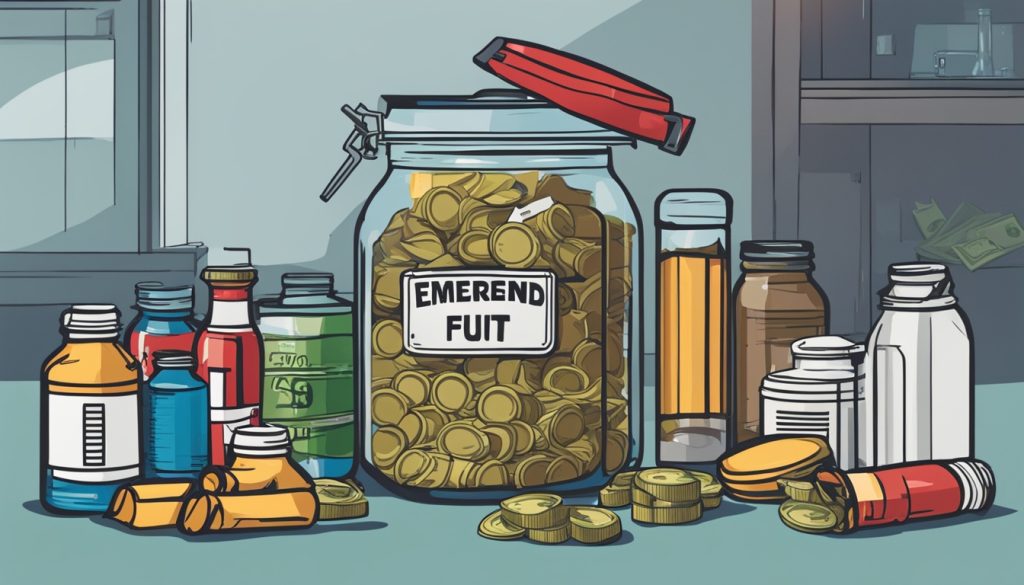In the world of personal finance, “cornerstone” is a key term. It means the base of your financial health, making sure it lasts through tough times. This base is vital for reaching your financial goals and keeping your money safe1.
Building a strong financial base is key to getting what you dream of. This article will show you how to make and strengthen your financial base. It will help you take charge of your money future.
Key Takeaways
- Financial planning is the foundation for achieving your investment and wealth management goals.
- 1 Setting specific, measurable, and achievable financial goals is essential for financial planning.
- 2 Developing a comprehensive financial plan can benefit people of all income levels, not just the wealthy.
- 1 Balancing short-term and long-term financial objectives is crucial for financial stability and security.
- 2 Budgeting and debt management strategies can help you achieve your financial goals.
Understanding the Financial Cornerstone
Your financial cornerstone is the base of your financial life. It includes an emergency fund, debt management, budgeting, savings and investments, insurance, and estate planning. These elements work together to make your financial life stable and secure. They help you reach your goals, both now and in the future3.
Emergency Fund: Your Financial Safety Net
An emergency fund is key to your financial security. Aim to save three to six months of living costs in an easy-to-get savings account. This fund helps cover unexpected bills, like medical expenses or losing your job3.
Debt Management: Handling Your Liabilities
Managing your debts well is vital for a strong financial base. Debt consolidation can lower your interest rates and make paying back easier3.
Budgeting: Structuring Your Income and Expenses
Budgeting is the core of your financial plan. By sorting your spending into areas like housing, transport, food, and fun, you understand where your money goes. This helps you find ways to save more3.
Savings and Investments: Growing Your Wealth
Setting financial goals is key to saving and investing well. Diversifying your investments helps you grow your wealth over time3.
Insurance: Protecting Your Financial Well-being
Checking your insurance needs is crucial. This includes health, life, car, home, and liability insurance. Having the right insurance protects your finances during unexpected times3.
Estate Planning: Ensuring Orderly Asset Transfer
Working with experts in estate planning ensures your assets go to your loved ones smoothly. They help you make a solid estate plan3.
Keeping a strong financial base means always learning more about finance. It also means regularly checking and adjusting your plans to fit your changing life and the economy3.
At Prevail, our financial experts are here to help you build and keep a strong financial base4. Call us today for a consultation and start securing your financial future4.
Building a Robust Emergency Fund
Your emergency fund is key to handling financial surprises. Start by setting clear goals, automating your savings, and checking on your progress often.
Set Clear Goals
First, figure out how much you need for your emergency fund. Aim for three to six months’ expenses56. This goal will guide you and keep you going as you save.
Automate Savings
Next, set up automatic transfers from your checking to a savings account for emergencies6. This way, saving becomes automatic, making it easier to grow your emergency fund5.
Regular Review
Keep an eye on your emergency fund regularly to make sure it matches your current finances5. This helps you adjust your savings and keep your emergency fund strong6.

“Having a solid emergency fund can provide a crucial safety net and peace of mind during unexpected financial challenges.”
By setting clear goals, automating your savings, and checking on your progress, you can create a strong emergency fund. This fund will shield you from financial troubles and aid in reaching your financial goals.
Effective Debt Management Strategies
Debt can block your way to reaching your financial goals. But, with the right strategies, you can manage it well. Start by understanding your debt, including interest rates and balances on each account7. Look at the interest on each debt and check your credit reports from three agencies to see which debts are the biggest problem7.
With a clear view of your debt, you can make a plan to pay it off. This might mean combining your debts into one with a lower interest rate, making payments easier and saving on interest7. Also, tracking your spending can show you where to cut back and use that money for paying off debt faster7.
There are different ways to pay off debt. The “avalanche” method targets high-interest debts first to save on interest8. Or, the “snowball” method focuses on the smallest debts first for a feeling of progress8.
Choose a strategy and make paying off debt a key part of your budget. Figure out the minimum payments for each debt, then add more money to the highest-interest or smallest debts7. This way, you’ll slowly pay off your debt and take back control of your finances.
| Debt Management Strategies | Description | Potential Benefits |
|---|---|---|
| Debt Consolidation | Combining multiple debts into a single, lower-interest loan | Simplified payments, potential interest savings |
| Avalanche Method | Prioritizing debts with the highest interest rates | Minimized interest charges over time |
| Snowball Method | Focusing on paying off debts with the smallest balances first | Sense of accomplishment, momentum for debt reduction |
Effective debt management is key to a strong financial base. By using these strategies and staying committed, you can take control of your debt and look forward to a better financial future9.

“Debt management is not just about paying off your debts; it’s about gaining financial freedom and peace of mind.” – Financial Advisor, XYZ Wealth Management
For more help and advice on debt management, check out trusted personal finance sites like www.familycredit.org, www.teachmefinance.com, and http://www.consumercredit.com/debt-management-program.html9.
Mastering the Art of Budgeting
Making a good budget is key to smart money management. By tracking your spending, sorting your expenses, and regularly checking and tweaking your budget, you can manage your money better10.
Track Your Expenses
Looking at your spending often helps you see where your cash goes. Many banks offer apps to help track and sort your spending. This gives you a clear view of what you need for now and later10.
Categorize Your Spending
It’s important to sort your spending into fixed and variable costs. Set aside money for things like rent, bills, and insurance. Also, plan for things you can change, like food, eating out, and fun10.
Create a Budget
Knowing what you earn and spend helps you make a budget. Allocate a part of your income to each category. Don’t forget to include paying off debt, saving, and investing10.
Review and Adjust
Keeping an eye on your budget is key. Experts suggest checking your budget every month or quarter. This helps you see how you’re doing, adjust as needed, and celebrate your financial wins10.
“The secret to achieving financial success is to create a budget and stick to it. It’s not about how much you earn, but how you manage your money.”
Learning to budget well lets you control your money, lowers stress, and helps you reach your financial goals11. Remember, budgeting is a journey. With hard work and flexibility, you can get the financial freedom you want11.
Saving and Investing for Financial Success
Getting financially successful is a journey that starts with smart saving and investing. First, set clear financial goals. Then, diversify your investments, save for retirement, and automate your savings12.
Set Clear Goals
Start by setting clear financial goals. These could be paying off debt, building an emergency fund, or saving for a big purchase12. Knowing what you want helps you make a plan to get there12.
Diversify Investments
Spread your investments to manage risk and increase returns13. Mix stocks, bonds, and mutual funds for a balanced portfolio13. This strategy helps you handle market ups and downs and grow your money over time13.
Contribute to Retirement
Retirement savings should be a priority. Use tax-advantaged accounts like a 401(k) or IRA to grow your savings faster13. Regular contributions mean more growth and less tax13.
Automate Savings
Automating your savings helps you build wealth consistently13. Set up automatic transfers to your savings and investments. This way, you’ll reach your goals without much effort12.
Financial planning is ongoing, so adjust your strategy as needed12. By following these steps, you’re on your way to a secure financial future14.
“Investing in yourself is the best investment you can make. It will not only improve your life, it will improve the lives of all those around you.” – Robin Sharma
Conclusion: Building Your Financial Cornerstone
Your financial planning journey is key to your investment success and financial health. By using the strategies in this article, you can build a strong base. This base will help you reach your financial goals and keep you steady through tough times. Financial planning is an ongoing process. It needs discipline, watchfulness, and a readiness to change as your life changes.
Starting from the beginning or improving your financial plan, focus on a full approach. This should cover everything from15 budgeting and managing debt to16 planning for investments and17 saving for emergencies. With the help of a skilled financial advisor, you can make a plan that fits your specific goals and how much risk you can take. This ensures your financial base is strong and safe.
Your financial cornerstone is the base of your long-term financial success and peace of mind. Putting in the time and effort to keep and strengthen this cornerstone means you’re investing in your future. You’re giving yourself the power to reach financial freedom and stability. Stick to your goals, and watch your financial cornerstone get stronger with every step.
FAQ
What is the significance of the term “financial cornerstone”?
The term “financial cornerstone” is very important in managing your money. It’s like building a strong foundation for your financial future. This foundation is key to reaching your financial goals and keeping your money safe.
What elements make up the financial cornerstone?
Your financial cornerstone includes key parts like an emergency fund, managing debt, budgeting, saving, investing, insurance, and planning for the future. These parts work together to make your financial life stable and secure.
Why is an emergency fund important for your financial cornerstone?
An emergency fund protects you from financial trouble. To build a good one, set a goal to save three to six months’ expenses. Use automatic savings to help you, and check your savings often to make sure it’s right for you.
How can you effectively manage debt to strengthen your financial cornerstone?
Managing debt right is key to a strong financial base. Make a plan to pay off debt, focus on high-interest debts first, and think about consolidating debts to lower interest. Avoid taking on new debt to keep your progress.
What is the role of budgeting in building your financial cornerstone?
Budgeting is your financial guide. Start by tracking your spending and organizing your money. Make a budget that sets aside money for each area. Check and adjust your budget often to keep on track.
How can savings and investments contribute to your financial cornerstone?
Saving and investing help you grow your wealth. Set clear goals, spread your investments to reduce risk, and use retirement accounts for tax benefits. Automate your savings to make it easier.
Source Links
- Mapping Your Future: Why Is Goal Setting Important in the Financial Planning Process
- Financial Planning Basics
- Best Practices to Build a Healthy Financial Cornerstone | Prevail IWS
- Homepage | Cornerstone Financial Solutions Inc
- An essential guide to building an emergency fund | Consumer Financial Protection Bureau
- How to Build an Emergency Savings Fund | Park University
- 7 steps to more effectively manage and reduce your debt
- Effective debt management
- Personal Finance and Debt Management
- Mastering The Art Of Budgeting
- Mastering The Art of Budgeting: A Step-by-Step Guide to Financial Freedom
- Financial Planning: What It Is and How to Make a Plan
- Saving and Investing
- 5 Ways Financial Planning Can Help
- What Is Financial Planning? Definition, Meaning and Purpose
- What Is Comprehensive Financial Planning?
- Building Your Emergency Fund: A Key Pillar of Financial Stability – Med Park Credit Union

